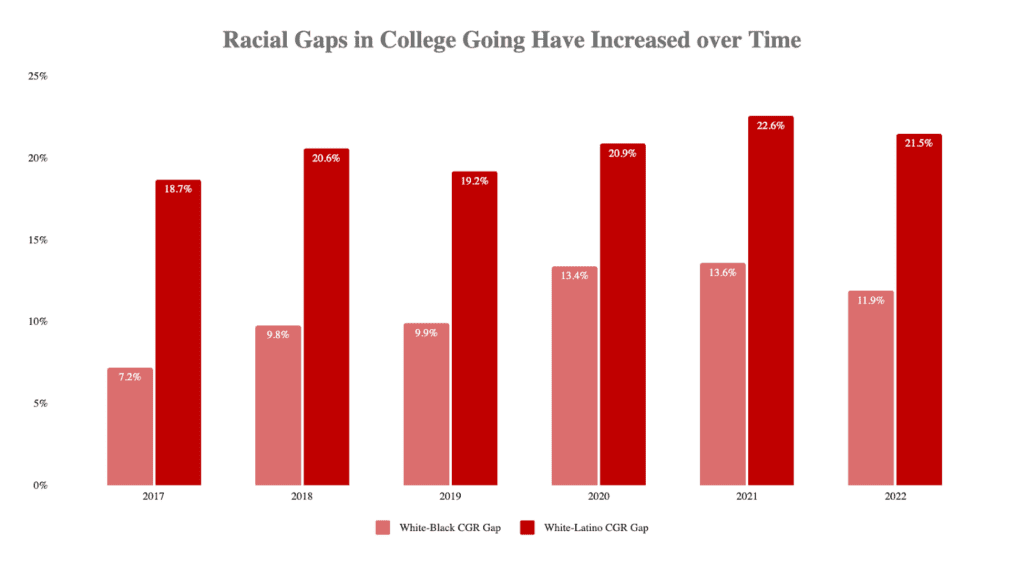5 Things Equity Advocates Should Know About… The Class of 2022 College Going Report
1. After years of significant decline, the college-going rate has increased by 1.5 percentage points.
Tennessee’s college-going rate (CGR), the percentage of high school graduates who enrolled in any postsecondary institution seamlessly after graduation, has increased to 54.3 percent. After years of decline precipitated by the COVID-19 pandemic – a nearly 9 point drop since 2019 – this modest 1.5 point increase is a welcome reversal of a concerning trend. As a result of the large declines in college going, the Tennessee Higher Education Commission (THEC) launched Momentum Year 2023 with a commitment to increase the number of Tennesseans who pursue higher education. While there is substantial work necessary to meet and maintain THEC’s 60 percent CGR goal for the Class of 2023, this increase represents an important step to recovery for Tennessee.

2. Race and gender gaps in college-going have shrunk, but remain much larger than in 2017.
Encouragingly, Black, Latino and male students’ college-going increased above the state average, narrowing wide pre-existing gaps. Black student CGR grew by 2.9 percentage points to 46.9 percent, Latino students increased by 2.3 points to 37.3 percent, and male students increased by 1.8 points to 48.3 percent. While these increases are a positive sign, gaps in college-going still remain far larger than they were in 2017, with a 12 point gap between White and Black students, and an over 21 point gap between White and Latino students. Less than 1 in 3 Latino male students and just 40 percent of Black male students enrolled in higher education and more must be done to support Tennessee’s students who were disproportionately impacted by the pandemic.

3. Of the high school graduates pursuing postsecondary education, far fewer are enrolling at Tennessee’s community colleges.
Despite Tennessee Promise, which allows students to attend a community college or Tennessee College of Applied Technology (TCAT) tuition free, the percentage of Tennessee high school grads who are going to the community college sector continues to decrease, making up approximately 40 percent of total postsecondary enrollment. This is a nearly 6 percentage point decline since 2018 – with more students opting to attend a TCAT (8.2 percent), Locally Governed Institution (31.1 percent), or an institution in the University of Tennessee system (19.7 percent.)
The amount of students who stay in Tennessee to pursue higher education has remained relatively stable at 85 percent, with about 10 percent of students attending an out-of-state public institution, and about 5 percent choosing to go to an out-of-state private institution.
4. Dual enrollment grant recipients pursue college at substantially higher rates.
Recipients of the Dual Enrollment Grant have a college-going rate of 78.4 percent, over 24 percentage points higher than their peers. Dual Enrollment and other Early Postsecondary Opportunities (EPSOs) have grown in popularity in recent years, and allow students in high school to build momentum towards attending and completing a postsecondary certificate or degree. While EPSOs are an important tool that encourages students to pursue higher education, research finds that Black and Latino students remain underrepresented in access to dual enrollment courses in Tennessee.
5. Tennessee is showing hopeful signs, through high FAFSA completions and Tennessee Promise applications, for the Class of 2023.
Students in the Class of 2022 were set to enroll in college when Momentum Year 2023 was launched – meaning that we have yet to see results of the initiatives that THEC has implemented. While official college-going data will not be known until next year, early signals like a record number of Tennessee Promise applicants and a second in the nation FAFSA completion rate provide hope that Tennessee’s college-going rate will continue to rebound. Advocates must continue to monitor and address disparities in college-going by race, gender, rurality, and income status, but early indicators signal important steps to recovery for Tennessee.
Equity Considerations
- As part of Momentum Year 2023, THEC asked various stakeholders about promising practices and needs to support more students to pursue higher education. What actionable steps will arise as a result of these findings, and who will the beneficiaries be?
- Momentum Year 2023’s second goal is to increase the number of adults who are enrolling via Tennessee Reconnect. What does outreach look like, and which communities are being targeted?
